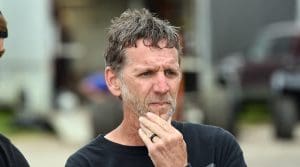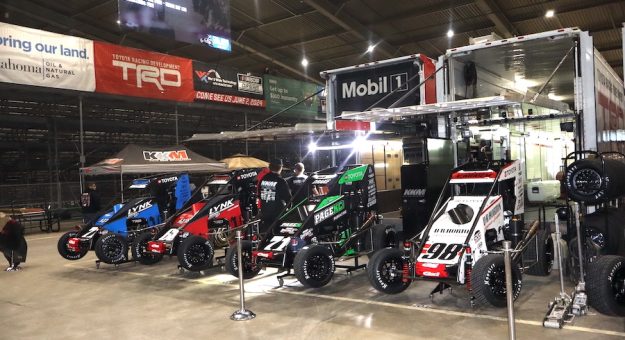TULSA, Okla. — Jay Drake stood at the perimeter of his busy Keith Kunz Motorsports compound, now even more hectic with the arrival of Kyle Larson to compete in Thursday’s preliminary event during the 38th Chili Bowl Nationals.
Drake appeared tired and admitted a nap would serve him well. Twenty-three years have passed since Drake took the checkered flag at Tulsa, an important endorsement on his Hall of Fame résumé. Much has changed at the Chili Bowl Nationals in the intervening years, and at present Drake longed for the days when the event comprised just three nights of racing.
Also different, and in much evidence this week, was the enforcement of rules with a greater emphasis on standard specifications promised in the future. On the one hand this made life easier for Drake and the KKM team.
“Before, as soon as we came back from the Turkey Night Grand Prix there would be bare frames at the shop and that is when we put together Chili Bowl specials,” Drake said. “Now to get ready for the new rules we just came here with some cars from the outdoor season. We still take them apart and maintain them like we would for any race, and they have new wraps and new body parts. Other than that, they are the same cars we ran in November.”
One might surmise that a crew fresh off a long season would be thrilled to just focus on refreshing the equipment in their inventory as opposed to starting from scratch. Yet, Drake acknowledges he longs a bit for the days of old.
“To tell you the truth I liked that people like Keith Kunz, Andy Bondio and Sammy Swindell would do different things. It really was the old days of run-what-ya-brung. I liked the engineering aspect of it. It was just like the Indy 500 used to be. You would see all kinds of crazy contraptions come out there that were neat to look at and it was fun to see how they performed. You had Roger Penske bring a Mercedes, and even further back when Andy Granatelli brought a turbine powered car. You will never see anything like that again. It made it more interesting.”
As much as he appreciates radical approaches to midget construction, when he grabbed a Golden Driller, he did so in a standard piece.
“The car I won with here was the same car I used to win the Pepsi Nationals and the Hut Hundred and a bunch of other races,” Drake said. “At that time only Andy Bondio seemed to have a special car. Several years after that they started building light weight chassis, putting fancy wings and body panels on them and things like that.”
It is doubtful that Drake could have imagined a time when KKM would bring 15 cars to an event. Nonetheless, he is convinced his team is equal to the task. Over the course of the year the squad brings three to seven cars to each USAC race, particularly during Indiana Midget week. The saving grace of the Chili Bowl is with five preliminary nights the workload is a bit more manageable.
“This group of guys have figured this out and have it down to a science,” Drake explained. “They are good at what they do because it isn’t an easy task by any means, but they are the best in the industry. The year before we had zero mechanical failures that put us out of a race. This past year there may have been one or two but those were parts failures. It wasn’t a case where one of the guys forgot to tighten a wheel or tighten a bolt.”
As the KKM program expanded Drake’s role within the team evolved as well. At first his primary task was to serve as a driver coach, but at that time Keith Kunz was the crew chief on every car. Because Kunz was so focused on the mechanical side of the program, he had little time to communicate with his drivers. Since that time many crew members have moved into the role of crew chief. This led to a reshuffling of duties. Drake sees nothing but positives in how racing operations are structured now.

“The crew chiefs we have now are as good as or better than me as a coach,” he said. “In my opinion the driver and crew chief relationship is key. Now we have three or four crew chiefs handling two or three drivers. Beau (Binder), Jarrett (Martin), and Brandon (Selph) have become very good at communicating with the drivers. We have found that direct relationships are important. I am always there for a back-up opinion.”
With all the discussion of organizational structure, crew chiefs, and roles it begged the question. With Kyle Larson now in the house, who would serve as his driving coach? It is here that Drake’s legendary dry wit came to the fore.
“Any time you can get Kyle Larson to drive anything it is a good thing,” he said. “Fortunately, I’m here to give him some tips. I’ll teach him how to get around in one of these things.”
Getting serious, Drake marvels at what Larson can do in a race car. He was asked what makes Larson so good?
“That is probably one of life’s mysteries,” Drake said. “In my opinion and probably many others he is just an anomaly. There is no other Kyle Larson in this world and maybe there never has been or will be. To show up at Eldora having never seen the place and winning three features in one night is unheard of. To go to IRP (Indianapolis Raceway Park) for the first time on pavement and set fast time in a midget and a sprint car is also unheard of.”
While his job description has changed his relationship with Kunz, now decades deep, remains strong as ever.
“I think we have similar personalities,” he said. “Neither one of us talks very much. There was always an inside running joke that he and I would show up at the track when I was racing for him, and we probably said one word to each other all night. But we went out and won races together. We knew what each other was thinking. He knew what I needed, and I knew that he knew what I needed. I let him go do his thing and he let me go do mine and we had a lot of success.”
Drake said it is a different feeling than winning as a driver, but it is still gratifying.
“I love seeing young kids come up and learn the craft, watch them progress, and finally win a race,” he said. “It is a neat feeling. It isn’t as fun as winning yourself, but it is still fun.”
He acknowledged that sometimes he feels the tug to race again but looks reality straight in the eye.
“The atmosphere has changed so much,” he said. “I mean, I didn’t get into a midget until I was 23 years old, and when I did, I was one of the youngest guys doing it. Now at 23, these guys have been doing it for 10 years. It is a whole different world.”
